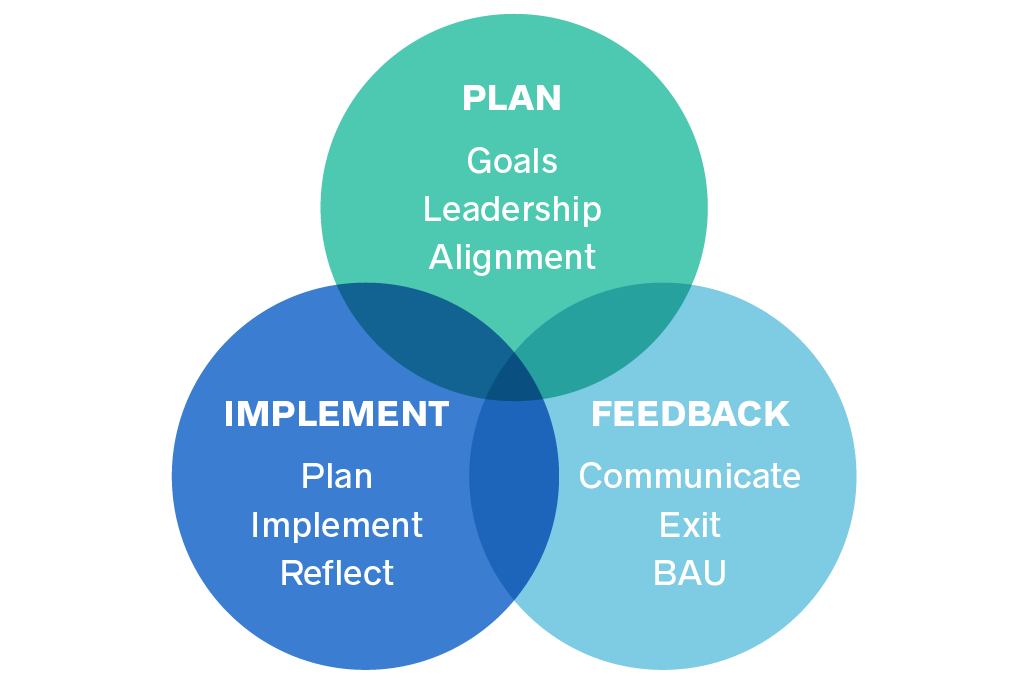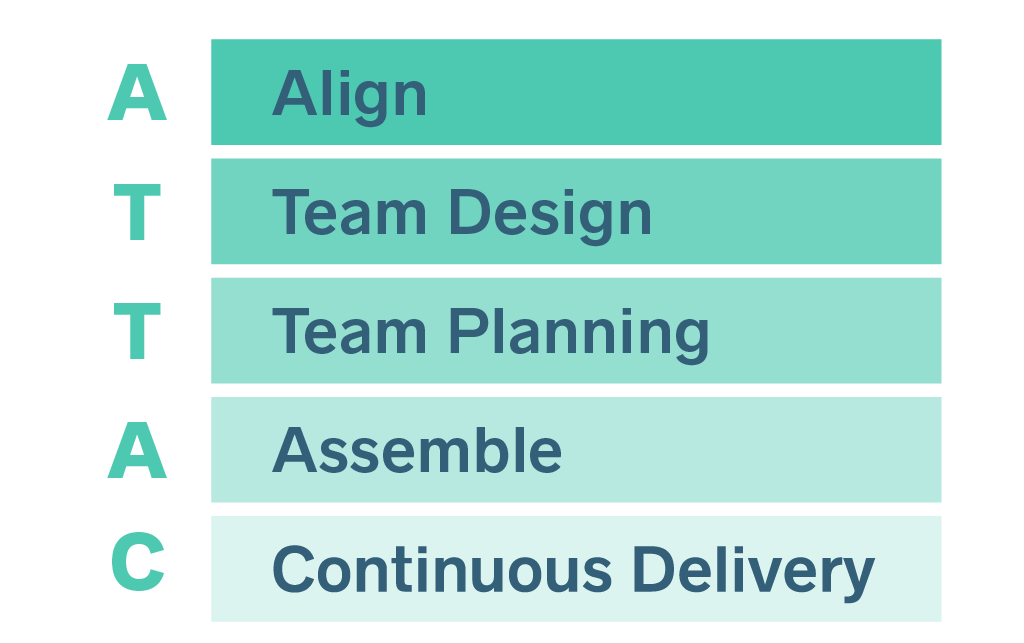Agile for Transformations: The Complete Guide

These days, it seems like everyone is undertaking a business transformation. Whether it’s about reorganizing to be more competitive, deepening customer connections, or simply accepting the inevitable, executives are obsessed with transformation – and that’s a good thing.
Identifying an opportunity to transform your business is only the beginning, however. To prepare for a business transformation – and to attain meaningful results – you must focus not just on completing the program but also on how you transform. Winning organizations have recognized that implementing a successful transformation is different from executing a new business strategy, and it requires a different approach.
In particular, many companies are looking beyond the classic tools of project management, change management, and future state design to techniques that are commonly used in software development, like Agile.
Proponents of the Agile methodology say it fosters closer alignment between workers and end users. Agile enthusiasts also boast that the methodology promotes greater independence and ownership among teams, which in turn leads to improved predictability and planning. And Agile offers a unique opportunity to redesign how work gets done both during and after transformations. By leveraging Agile, my consulting practice has delivered complicated transformational programs more predictably and cost effectively. We have also helped clients lay a foundation for moving toward an on-demand talent model and creating a more agile organization.
So how do you start employing Agile techniques during transformational initiatives? In a recent white paper, I introduced a methodology I call “Agile for Transformations” that details how leading organizations can use Agile techniques to foster change and deliver transformational programs faster and more cost effectively.
Below, I’ll summarize the paper and outline when Agile techniques are appropriate, how to introduce them into your organization, and how to tailor them to your specific needs and timing. To see a complete copy, please do reach out.
What’s Unique About Transformations
A business transformation is about changing how your organization operates. To succeed, you must develop an approach that reflects your goals and encourages organizational learning and culture development throughout. You must also make sure that your organization is ready to transform. This is particularly true with digital transformations, where focusing on new technologies often causes people to lose sight of business goals and transformations become more about integrating new systems than driving meaningful change.
To avoid such an intrinsic issue, ensure your transformation is:
- Sponsored by management. Are leadership and key stakeholders aligned on the goals, objectives and expected outcomes of the effort?
- Adequately resourced. Do you have subject matter experts – whether internal or external to the company – who can participate without harming business as usual?
- Adequately funded. Transformations typically require a heavy investment of time, money, and resources. Is your organization prepared for these expenses? Are you prepared to see the change through? Does the cost of the transformation outweigh the risk of doing nothing?
- Quantifiable. Can you articulate the benefit you expect from the transformation? Are your stakeholders aligned on that benefit, and can you express it with meaningful metrics?
- A departure from business as usual. Transformations are different and disruptive. They require more thought around change, investment, and staffing than typical programs. They also require you to make a clear-eyed assessment of whether your organization is truly ready. Will people accept the change, or will they revert to tried and true methods when the going gets tough? Can you articulate what’s in it for them?
By revisiting these questions throughout your transformation, you can continuously reorient the program towards its goals and help achieve your vision for the future.
Why Agile?
Before Agile became one of the business world’s biggest buzzwords, it referred to a methodology for developing software. Centered around an iterative, team-based approach, Agile replaced detailed requirements with terse, user-defined stories organized in a hierarchical structure. These stories are planned in a product backlog, and development occurs in fast-moving cycles known as "sprints." At the end of each sprint, the team demonstrates the value and usability of the work they’ve produced.
Among the documented benefits of using Agile are improved productivity, visibility, and business/product alignment. On transformations, Agile also improves predictability, accountability, motivation, communication, and alignment with stakeholders and customers.
But the push for Agile doesn’t end there. Increasingly, it has also become a key delivery success factor for digital transformations, as leaders recognize that continuous delivery with end users and closer business/product alignment are key factors for success. Some business leaders have looked to Agile principles as they attempt to make entire organizations more flexible in the face of change. These factors are core drivers for the broader adoption of Agile outside of software development and a key reason to consider using Agile during transformational initiatives.
Of course, moving to Agile is not without challenges – first among them, knowing when and how to implement Agile to its maximum advantage.
Using Agile For Transformations: Knowing When
Using Agile for transformations starts with understanding how transformational initiatives unfold. To do this, we posit the model below which illustrates the fluid nature of transformations. The model, of course, builds on general change management theory in the digital age, where each phase may present at any time. A properly trained Transformation Lead will understand this, know how to recognize it, and then adjust the toolset to maximize the team's output. This is how leading transformation specialists unlock multiples of value.

Exhibit 1: The Simpel Transformation Framework, Copyright Simpel and Associates, 2019
Plan. This phase is all about clarifying goals and aligning leadership.
Implement. The Implement phase concerns planning and doing the work. This is where the use of methodologies, such as Agile and feedback loops, comes in to play.
Feedback. Feedback is about recognizing when it’s time to begin shifting to business as usual or back to planning. The idea is to listen, learn, and react so you can complete the move from a transformational initiative to the future state.
Transformation Leads sit at the center of everything. If the principles can guide your transformation through these shifts, they will nurture the emergence of a new operating culture organically rather than forcing it via a standard "change and culture" program, as is so often the case.
So when should you introduce Agile? Here are a few times it may make sense:
- You are in the change phase. Agile will help keep your team engaged, productive, and accountable for all deliverables.
- Requirements are ambiguous. Agile is a great way to smash through comments like “I have no idea where to start” or “this project is so big and there is so much detail that we don’t know how to make a decision.”
- Team resources are rapidly shifting. Agile can help teams stay focused when resources or needs are in flux and the need for communication and openness is at a peak. Responding to this symptom with Agile is fundamental to designing the on-demand staffing model.
- You have or can get a strong Product Owner and Scrum Master. Agile will not work without a strong leader and Scrum Master to oversee the effort. If you don’t have the right resources or can’t get them, then don’t do it.
- The team is falling behind and you need a new approach. Agile can also be used as a mechanism to jumpstart a flagging team that has run out of gas. I’ve used the intervention effectively on carve-outs, stand-ups of centers of excellence, and multiple forced transformations (responses to regulation).
Using Agile For Transformations: Understanding How
Once you’ve determined that the time is right to use Agile, we use a variety of approaches to ensure it is implemented properly. One of these approaches we call the ATTAC method. Here’s how it works.

Exhibit 2: The Simpel ATTAC Framework, Copyright Simpel and Associates, 2019
- Align. Start by aligning your leadership and your team about the use of Agile. Making changes in any program’s operations can be challenging – even more so when adopting Agile. Preparing the team for the change is critical for success.
- Team Design. Team Design is about ensuring that you have the right resources available and can design a governance structure to enable your Agile and non-Agile teams to coordinate their work continuously.
- Team Planning. Here's where Agile delivery begins. Collectively, the team maps the project and constructs a backlog broken into tasks and a sprint plan. Team members must change how they think about work. It is incumbent upon the Transformation Lead to work closely with the product owner to properly identify the places where Agile is appropriate. It is also the Lead’s responsibility to ensure a master, integrated project plan that brings Agile and non-Agile work together in a seamless, integrated fashion.
- Assemble. During the Assemble portion, the team works through their sprint cycles to deliver valuable work products. You’ll leverage Agile’s work breakdown structure and its definition of “Done.” You’ll also need to monitor closely for fatigue and dissension. Teams unaccustomed to Agile will quickly burn out and turn on the Transformation Lead. Balancing delivery with sensitivity to the team’s morale is an important consideration for when evaluating whether and when to pull back.
Evangelists will tell you that Agile gets better with practice, and it is the Lead's responsibility to make it so. As the Lead, product owner, and team work together and begin delivering, a new culture will form, and new modes of thinking will be established. If nurtured, new operating cultures will unfold once the transformation initiative ends.
- Continuous Delivery. The final part of implementation is Continuous Delivery. This is one of the core benefits of Agile, since it enables users to interact frequently with completed pieces of work. If implemented properly, it will clarify open questions and limit integration risks. It will also help team members who have to live within the new future-state environment to gain comfort with the result and to lay the groundwork for the ongoing use of Agile in the company’s future state.
Your Transformation Lead should work to manage the feedback loop. As the iterative delivery unfolds, the Lead must constantly monitor the situation and initiate/encourage dialogue, so the change sticks and a new culture emerges.
When realized properly, savings can be substantial. Imagine completing a transformation for one-third of the traditional cost and reducing ongoing costs and operational risk? We have seen comparable results in our practice and believe the trend will continue as more organizations look to methodologies like Agile for transformations.
Building an Agile Workforce
The Agile methodology is all about empowering development teams to make fast, intelligent decisions about where to go next. By deploying so-called big-A Agile, you can start to build a more broadly agile organization. You will match the right talent to the right challenges and opportunities and become more receptive to change as it occurs while maintaining predictability in the outcome.
The growth of the gig economy enables us to take this a step further by disrupting traditional talent management norms, both during a transformation and after it. Agile teams need access to the right resources (internal and external) at the right time. By leveraging a mix of contractors, managed services, and big firms, companies have a unique opportunity to create a more efficient and economical solution to staffing.
New Agile HR technologies – like flexible employee benefits and human cloud models – are helping to make the notion of on-demand staffing even more of a reality. When used together with the right governance and operating model, they provide a powerful mix that supports implementation of on-demand staffing.
Agile represents a shift in mindset, and the promising results it has yielded will only grow as companies become more adept at applying its principles to other areas of work. Through a structured approach, Transformation Leads have an opportunity to bring the benefits of Agile to enterprise-wide change initiatives. Results include faster, more effective, and more cost-effective delivery. More importantly, Agile helps facilitate a closeness and a culture that will permeate the new organization once the program ends and business-as-usual begins.
This article was condensed and edited from a whitepaper published by Simpel and Associates, LLC.
Get the Skills You Need
Thousands of independent consultants, subject matter experts, project managers, and interim executives are ready to help address your biggest business opportunities.